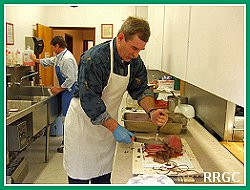Food Safety
Wild Game Food Safety
Capt. Clark
Christmas Wednesday 25th December 1805
We would have Spent this day the nativity of
 Christ in feasting, had we any thing either to raise our Sperits or even gratify our appetites, our Diner concisted of pore Elk, So much Spoiled that we eate it thro mear necessity, Some Spoiled pounded fish and a fiew roots. Christ in feasting, had we any thing either to raise our Sperits or even gratify our appetites, our Diner concisted of pore Elk, So much Spoiled that we eate it thro mear necessity, Some Spoiled pounded fish and a fiew roots.*
The first step in processing wild game is to follow safe food handing practices. These safety practices are the same for both domestic and wild meat. However, wild game is not subject to inspections by federal or state programs; therefore, it is up to you and equal care is necessary. In each step of food preparation you should:
If the meat has been frozen, thaw it in the refrigerator, in cold water or in a microwave. Do not set it on a counter top to thaw because there is a potential for bacteria to grow as the meat thaws. If you are going to marinate the meat, place it in a covered container in the refrigerator. Refrigeration will prevent bacterial growth.
All game meat, fish and bird must be stored and cooked at safe temperatures to keep food safe from bacteria that cause food borne illness.
In general, following good food safety practices that are recommended for domestic animals will be adequate for wild game. However, improved management of feeding practices for domestic animals has resulted in a decline of diseases and less safety concerns for diseases such as trichinosis in domestic pigs. This is not the case for wild animals and trichinosis has been found in wild hogs, bears, wild felines (cougars), and other carnivorous animals. In some cases trichinosis has been found in deer but this is rare and it depends on where the animal feeds.
To be safe, if you harvest an animal that is a risk for trichinosis, you should:
There are documented cases in Washington, Idaho and New Mexico where hunters have become ill with trichinosis after eating undercooked cougar meat.
|
||
